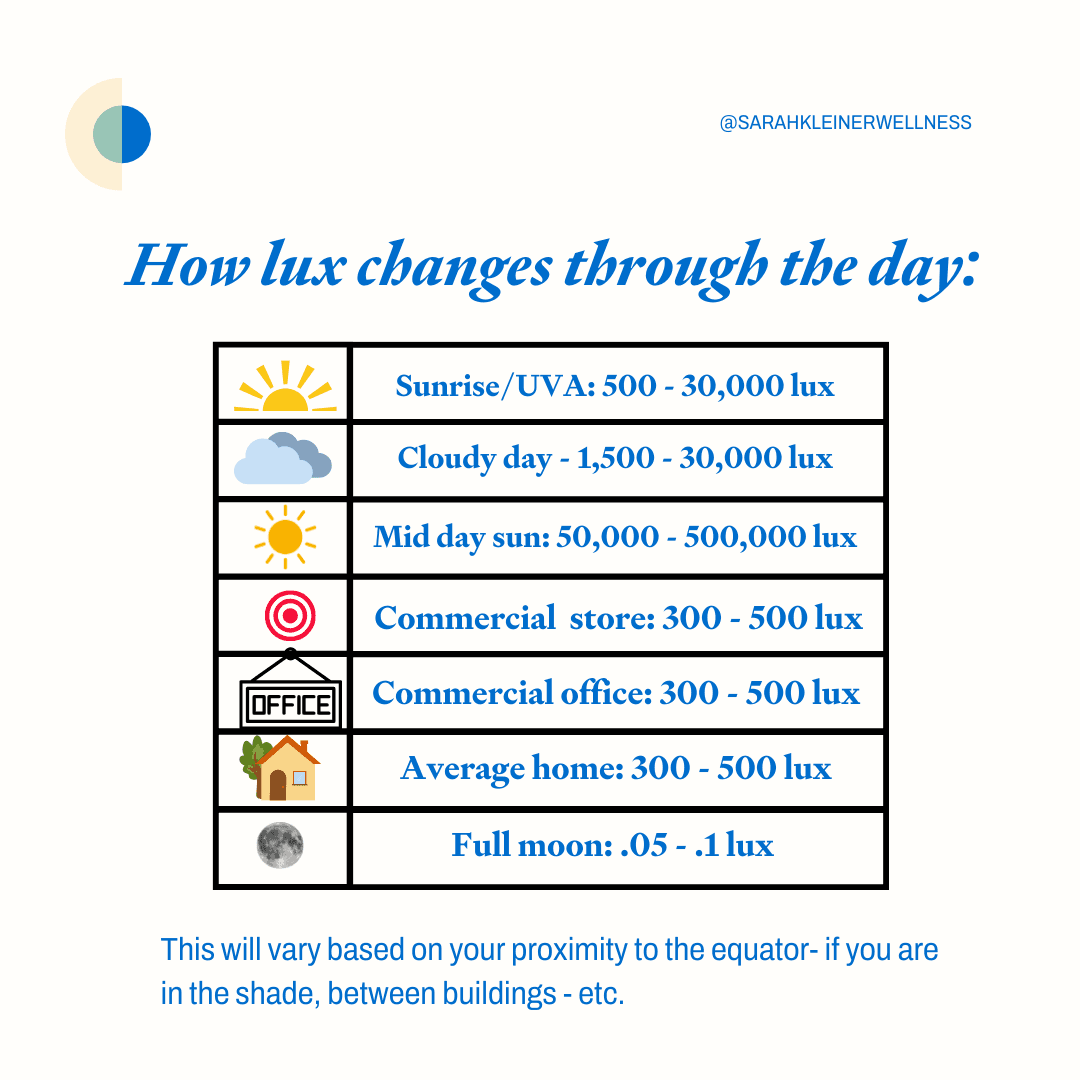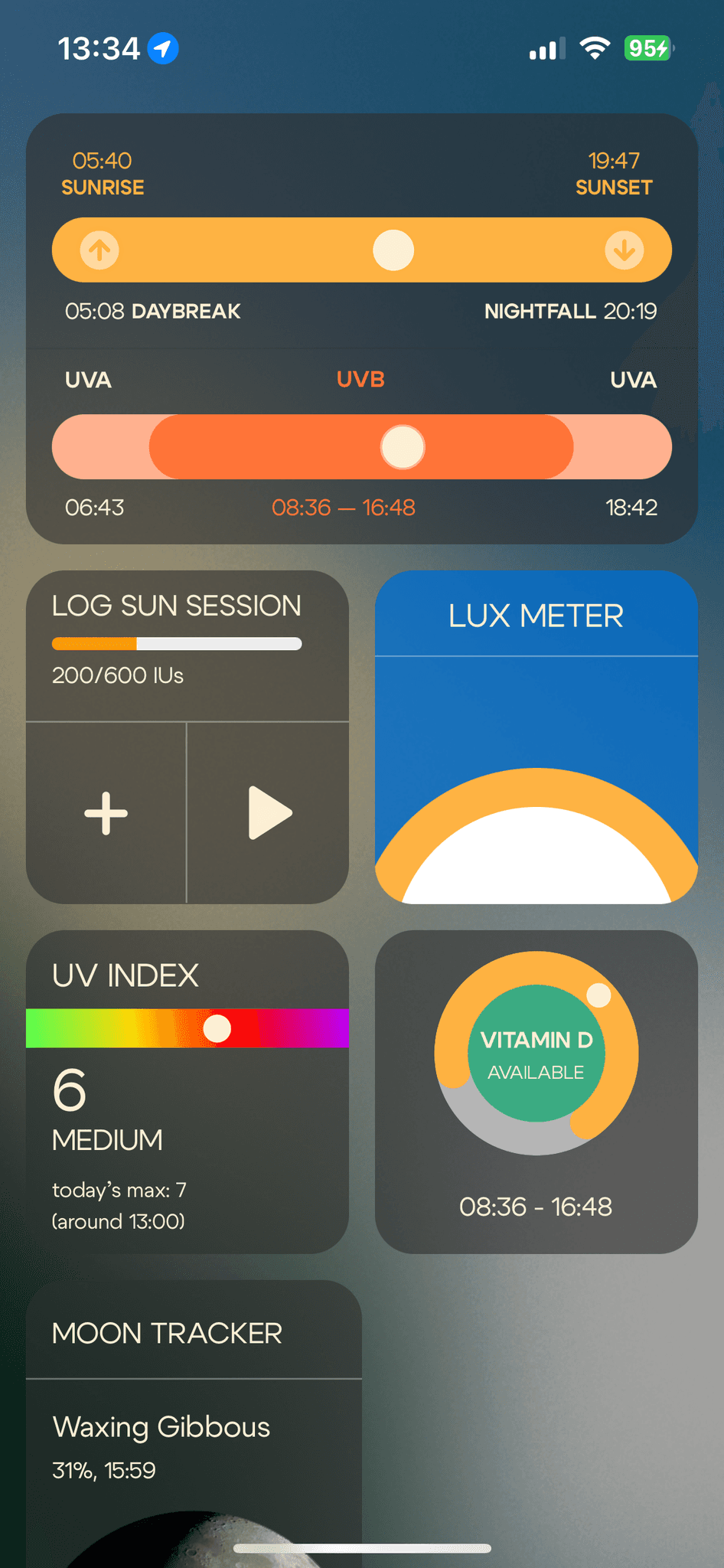
Lux Meter
Click the video below to watch a video about how to use the lux meter & why lux matters for your health:
Lux, a measure of light intensity, is crucial for health because it directly influences various physiological and psychological processes, especially those related to circadian rhythms, mood, and hormone regulation.

Here’s why lux matters in health:
1. Regulation of Circadian Rhythms, Metabolism & Mental Health
Lux plays a key role in entraining (synchronizing) the body’s circadian rhythms, which are the natural 24-hour cycles that regulate sleep, wakefulness, and many other bodily functions. Adequate exposure to bright light, especially during the morning, helps signal to the brain that it's time to be alert and active. This process primarily occurs through light exposure to the eyes, which influences the suprachiasmatic nucleus (SCN) in the brain, the master clock of the circadian system.
Low Lux (Dim Light): Insufficient light exposure, especially in the morning, can disrupt circadian rhythms, leading to sleep disorders, fatigue, and impaired hormone regulation.
Study - 2,500 Lux in the morning is needed for healthy metabolism - https://www.ncbi.nlm.nih.gov/pmc/articles/PMC10056135/
Study - 2,500 Lux is needed to support conditions like depression & anxiety - https://www.ncbi.nlm.nih.gov/pmc/articles/PMC6746555/
On a clear, sunny day, the maximum lux level can reach approximately 100,000 lux when standing outdoors in direct sunlight. This level can vary slightly depending on geographical location, altitude, and time of year, but 100,000 lux is a typical peak measurement for full sunlight around midday.
On a rainy, overcast day, the maximum lux level typically ranges between 2,000 to 10,000 lux. This can vary depending on the intensity of the cloud cover and rain, but it is generally much lower than on a clear, sunny day.
The maximum lux level indoors typically ranges from 300 to 1,000 lux under artificial lighting, such as in well-lit offices or rooms with bright overhead lights. However, it is rare to achieve lux levels indoors comparable to those found outdoors in direct sunlight.
2. Melatonin and Sleep
Lux levels directly influence the production of melatonin, the hormone that promotes sleep. During the day, exposure to bright light suppresses melatonin, helping you stay awake and alert. As evening approaches and lux levels drop (especially after sunset), melatonin production increases, preparing the body for sleep.
3. Cortisol Regulation
Lux also affects cortisol, a hormone that plays a crucial role in the body’s stress response and helps with wakefulness in the morning. High lux exposure in the morning can trigger the Cortisol Awakening Response (CAR), which gives you the energy needed for the day. If lux levels are too low in the morning (such as staying indoors in dim light), cortisol production may be impaired, leading to grogginess and difficulty waking up.
5. Eye Health and Vision
Lux is also important for eye health. Sufficient exposure to natural light, particularly during childhood, is believed to reduce the risk of developing myopia (nearsightedness). Spending time outdoors where lux levels are higher helps maintain healthy eye function and supports visual development.
Myopia Prevention: Studies suggest that higher lux exposure outdoors may help prevent the development and progression of myopia, especially in children.
6. Energy and Productivity
Exposure to higher lux levels during the day promotes alertness, focus, and productivity. Offices and indoor environments that are poorly lit (with low lux levels) can contribute to fatigue, sluggishness, and a lack of focus. Bright light environments, especially those with adequate natural light, help improve cognitive performance, concentration, and overall energy.
7. Hormone Regulation
Lux levels affect other hormones beyond melatonin and cortisol, including leptin (which helps regulate appetite) and insulin (important for glucose metabolism). Bright light exposure can support the balance of these hormones, helping maintain healthy metabolism and reducing the risk of metabolic disorders.
Optimal Lux Levels:
Morning: Ideally, you should be exposed to bright light (2,500--10,000 lux) within the first couple of hours of waking to support your circadian rhythm.
Afternoon: Continued exposure to moderate light (around 10,000 lux or more ) during the day helps maintain alertness. (this is why it is important to take light breaks!)
Evening: Lower lux levels (below 500 lux) are important in the evening to signal the brain to start winding down for sleep, with exposure to as little as 5-50 lux from screens being sufficient to disrupt melatonin production.
The light intensity changes during the course of a day from about 100 lux at sun rise to 100 000 lux at noon (close to the equator even 500 000 lux), declines afterward in the same way as it increased, until it reaches 0.001 lux in a night without moon.
Source:
https://www.researchgate.net/figure/The-light-intensity-changes-during-the-course-of-a-day-from-about-100-lux-at-sun-rise_fig24_308906640
In summary, lux is a critical factor in maintaining optimal health. Proper light exposure, both in intensity (lux) and timing, helps regulate your body’s circadian clock, improves mood, supports hormone balance, enhances eye health, and boosts overall well-being.
Our latest stories:
See all posts





